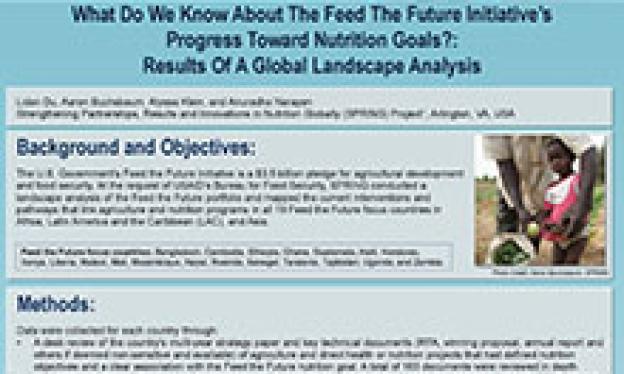Authors: Du L; Buchsbaum A; Klein A; Narayan A
Background and objectives: The U.S. Government's Feed the Future Initiative is a $3.5 billion pledge for agricultural development and food security. At the request of USAID’s Bureau for Food Security, SPRING conducted a landscape analysis of the Feed the Future portfolio and mapped the current interventions and pathways that link agriculture and nutrition programs in all 19 Feed the Future focus countries in Africa, Latin America and the Caribbean (LAC), and Asia.
Methods: Data were collected for each country through:
• A desk review of the country’s multi-year strategy paper and key technical documents (RFA, winning proposal, annual report and others if deemed non-sensitive and available) of agriculture and direct health or nutrition projects that had defined nutrition objectives and a clear association with the Feed the Future nutrition goal. A total of 163 documents were reviewed in depth.
• Key informant interviews with USAID Missions’ points of contact and representatives from implementing partners; 35 individuals were interviewed in total. The data analysis utilized seven agriculture-nutrition pathways developed by IFPRI and a set of key guiding principles for improving nutrition through agriculture developed by the FAO. The analysis determined whether and the extent to which these pathways and principles had been applied in the Feed the Future projects in order to enable agriculture to improve nutrition in target populations.
Results: All countries adopted a “value chain” approach. Staple foods were the most commonly selected value chain items. While horticulture, legumes and animal products were mentioned in several countries, significant variations existed with regard to the varieties selected and the scale of investments. Specific descriptions were not provided in documents reviewed from a number of African countries (Figure 1). The most commonly adopted agriculture-nutrition pathways assumed that increases in agricultural production and income would lead to either greater consumption or purchase of nutrient-dense foods and improved nutritional status. The implications of women’s time, labor burden, and control of income on nutrition were not as adequately addressed in African countries as opposed to those in Asia and the LAC region (Figure 2). Most countries relied predominantly on general nutrition education as the nutrition intervention.
Conclusions: Staple foods are priority value chain items in most Feed the Future countries. Nutrient-dense items were also focused on in some countries. Since many missions selected child stunting (n=18), minimal acceptable diet (n=14), and maternal anemia (n=11) as key nutrition indicators, the availability and accessibility of diverse and nutrient-dense foods needs to be improved in local markets close to populations targeted by Feed the Future projects. The effectiveness of these projects could benefit from comprehensive social and behavior change communication strategies with a special focus on improving women’s influences in these decision-making processes to increase the nutritional value of diet through all links along the agriculture-nutrition pathways (Figure 3).
